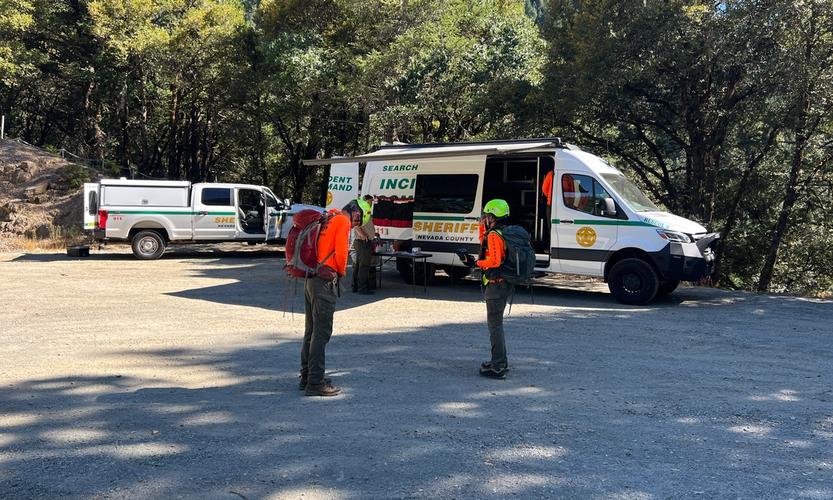Fuels Reduction Work Halted, Frustrations Increase
June 20, 2024

Wolves, for which the fuels reduction projects were stopped, may have an effect on the deer population as their numbers increase. This buck, spotted in a Downieville yard on Tuesday, is not currently being chased by one.
LOYALTON — The California Department of Fish and Wildlife (CDFW) halted progress on the Smithneck and Antelope fuels reduction projects, due to a new permitting process apparently triggered after wolves had been spotted in the area. At the meeting of the Sierra County Board of Supervisors on Tuesday, Supervisor Sharon Dryden led a discussion voicing the frustrations of several locals and businesses involved in and benefiting from the projects.
Danielle Bradfield, a Feather River Forestry forester, explained that out of the 723 acres of fuel work needed to meet grant guidelines, 638 had already been completed when a CDFW biologist showed up and shut the project down. First, a nesting bird survey was required. After CDFW completed that survey, the project lost 10 to 15 acres in scope. Bradfield detailed that a survey now had to be completed weekly during operation, requiring a complicated back-and-forth with CDFW and losing the project at least a full operational day per week. Additionally, the fuels reduction treatment was changed, with CDFW specifying that 80 to 95% of bitterbrush must be left untouched, potentially affecting the integrity of the fuels work. Also, due to CDFW’s concerns about a wolf pack in the area and the potential mastication of a wolf den, operations have been suspended until further studies are completed.
Rod Rummel, Executive Director of Sierra County Fire Safe & Watershed Council, then updated the Board that the Antelope project had been suspended for the same reasons, just two weeks before a contractor had been scheduled to start work. An estimated restart date no earlier than September 15th was established, though CDFW assured Rummel that studies were being completed attempting to speed up the timeline.
Executive Director of the Sierra Valley Resource Conservation District, Victoria Fisher, made clear that reducing the land area treated put the projects at risk of failing to meet grant guidelines. She also summarized what all previous speakers had brought up: communication with CDFW has been poor. All speakers believed that a good relationship had been established with CDFW in the past with open communication channels, but a suspected personnel change within the department in the last two years has closed those channels. Projects were shut down without notification to contractors or foresters, and the now-required permitting process is confusing and not readily available. Fisher noted that funding for administrative tasks would need to be increased, which was not budgeted for in the Smithneck project grant. She worries that this precedent will discourage any future fuels reduction work.
Rick Roberti, Board Chair of the Sierra Valley Resource Conservation District, highlighted CDFW’s lack of ability to manage wildlife properly. Roberti believes the meticulous preservation of nesting birds by CDFW is hypocritical, given that ravens, which have exploded in population, have destroyed “nest after nest” without management. He believes that Sierra and Plumas County ranchers are better environmentalists than people who live in cities and have little understanding of nature. Roberti blamed CDFW for a decrease in deer and populations from bear and mountain lion overpopulation and claimed that ranchers were not being compensated for animals being killed or mutilated by wolves.
Sierra County Sheriff Mike Fisher echoed the sentiment of the speakers, specifically voicing concern over the lack of communication with CDFW, which he had experienced in dealing with bear issues. Fisher believes that “there would have to be a bear in this room right now being aggressive toward a human” before the department would declare a bear a threat to public safety. Supervisor Lee Adams also disapproved of the fuels work stoppage, saying that out of 640,000 acres of forest, he couldn’t believe the department was playing with 80 of them. He also echoed Roberti’s idea that Sierra County residents have better environmental instincts than people living in cities, saying that there were 40 million people in the state watching Disney movies versus the few thousand in Sierra County who live in nature and joking that the grizzly bear, once native to San Francisco, should be reintroduced there.
Featured Articles

Sheriff’s Office Accepts $60,000 Grant for New Search and Rescue Team →
December 2, 2025
Sierra County to enhance emergency response with grant-funded search and rescue team initiative.
Confusion Surrounds Release of the Plumas County Grand Jury’s Report →
December 4, 2025
WCB Considers Grant for Sierra Valley Tribal Land Purchase →
Updated November 22, 2025
Downieville Fire Auxiliary Hosts Annual “Holiday on Main” Event Saturday →
December 2, 2025
Flood Forces Temporary Closure of Sierra Hardware →
December 3, 2025